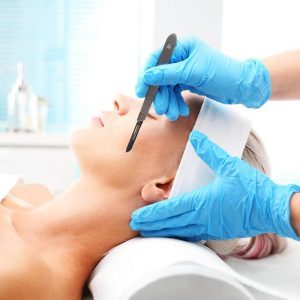
Dermaplaning
Dermaplaning is a super effective, painless exfoliation treatment producing instant results with no downtime. With the help of a sterile surgical scalpel, dead, dull skin cells are gently skimmed off the skin and ‘peach fuzz’ facial hair is removed.
It can remove 2-3 weeks worth of skin layers in one session to reveal a bright, fresh complexion underneath.
It is not meant for terminal (coarse) hair but it can be used for a variety of facial optimisation purposes.
Dermaplaning is non-invasive and doesn’t require a difficult recovery. It’s used by those wanting a more youthful and soft complexion, to minimise dullness and the appearance of minor skin damage.
Dermaplaning should be painless, but you may feel a little tingling or heightened sensitivity as the top skin cells are removed. The procedure is carried out with you lying down and a session usually takes around half an hour. Once completed, the provider will usually apply a soothing balm as well as sunscreen.
It’s not unusual to experience some redness for a few days immediately following dermaplaning. It takes a few days before you can appreciate the full results.
Benefits of dermaplaning
- Enables better product absorption: When you apply creams and serums to your face, they need to penetrate the top layers to fully benefit your skin. With dermaplaning, the top layer and dead skin cells are removed, meaning the product can penetrate more deeply. Your makeup can also be applied more smoothly.
- Removes peach fuzz: The fine soft hairs on your face will be completely removed with dermaplaning, leaving your skin clear and soft. This fine hair can trap sebum and dirt, leading to breakouts.
- Gives you lovely soft skin: Your face will feel extremely soft and smooth.
- Reduces the appearance of acne scars: Dermaplaning reduces the visible appearance of their depressed acne scars.
- Reduces the appearance of lines and wrinkles: dermaplaning gives a more youthful complexion with less noticeable fine lines and wrinkles.
- Enhances radiance: By removing the dead skin cells, dullness is eliminated and you will experience a more radiant complexion.
- Non-invasive and minimal recovery: This isn’t a complex cosmetic procedure, and within a few days you’ll notice the benefits. No chemicals are used.
- Is suitable for most people: All skin types can generally use dermaplaning safely.
Assessment
It is required before your first treatment
Duration
30 minutes
Discomfort
almost none
Downtime
minimal to none
Treatments No.
several
Longevity
4 – 8 weeks
Dermaplaning FAQ
Anyone whose skin is not too sensitive, who does not have active facial acne, rosacea, keratosis pilaris or a compromised skin barrier is eligible for dermaplaning. It is also possible to undergo dermaplaning when pregnant or breastfeeding.
If you are acne-prone, dermaplaning may be possible when you are not dealing with a breakout. During active breakouts dermaplaning may increase the likelihood of inflaming the skin and spreading bacteria, making acne worse. However, if it is carried out when your skin is calm, it may help to reduce further breakouts by removing dead skin cells which can clog pores.
Yes. Dermaplaning is suitable for men, as long as they meet the above criteria. However, dermaplaning for men should be considered a cosmetic dermatology treatment and not a hair removal option. This is especially true for men whose facial hair is particularly coarse. An additional benefit of dermaplaning for men is, in some cases, the reduction of ingrown hairs in the beard area.
The mechanical action of the scalpel could be compared to shaving. It does have additional benefits not seen with regular shaving, due to the exfoliation process.
No. Your hair will grow back at the same rate and have the same texture it had before the procedure. Thicker hairs may feel more coarse as they have a sharp edge. The soft peach fuzz hair will grow back slowly – usually in about four weeks – and will be no different than it was previously.
Dermaplaning is not simply a method of facial hair removal. It offers additional benefits, including exfoliation and smoothing the skin. However, it does also remove hair from the face BUT this is only the fine, wispy hairs known as ‘peach fuzz’. Therefore, it depends on your specific situation, hair density and desired outcome as to which hair removal option works best for you.
Again, this depends on your specific needs and expected results. Professional dermaplaning can generally be safely carried out every 4-8 weeks but you should consult your aesthetics practitioner for a personalised timeline. Dermaplaning is also suitable as a one-off red carpet treatment.
Your skin may be sensitive to the sun following treatment. Therefore, it’s recommended you wear sun protection for the rest of the day immediately after your treatment. We recommend the use of a broad spectrum SPF 50 or SPF 30. Also, take a break from using retinol treatments and glycolic acid skincare products for 48 hours after your session. This is because they may irritate your newly exfoliated skin.
Dermaplaning can work well with other treatment procedures, such as chemical peels and microneedling. This is because it can enhance the penetration of active ingredients and make other cosmetic skin treatments more effective. Some popular combinations include dermaplaning and microneedling, dermaplaning and a chemical peel. These treatments are deeper in terms of skin penetration and have potential complications, so not everyone will be suitable.







